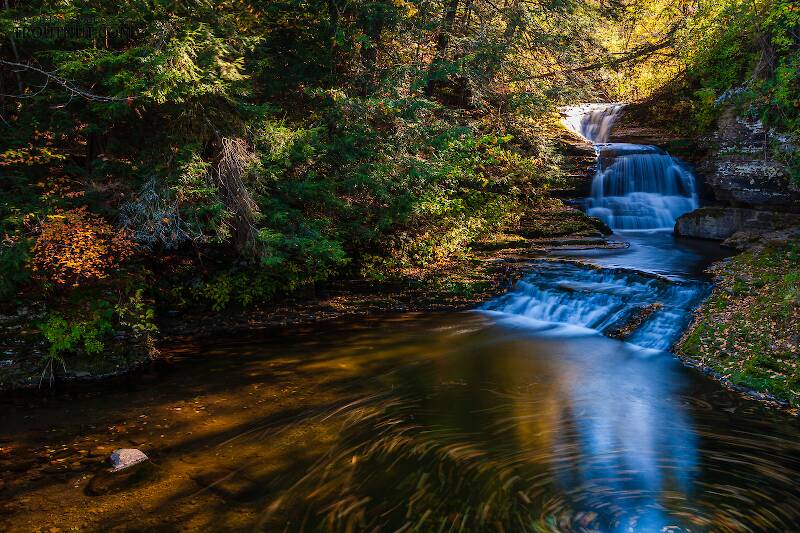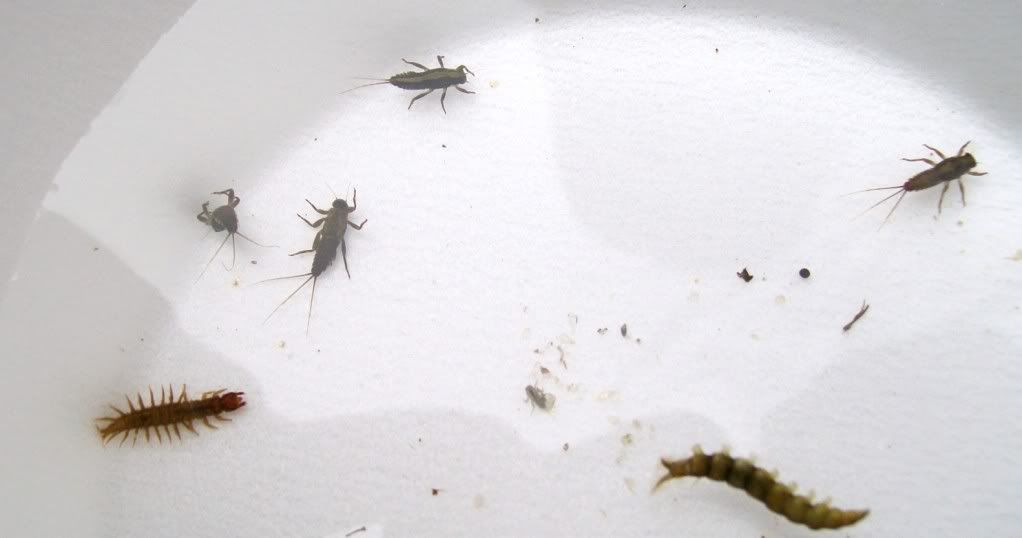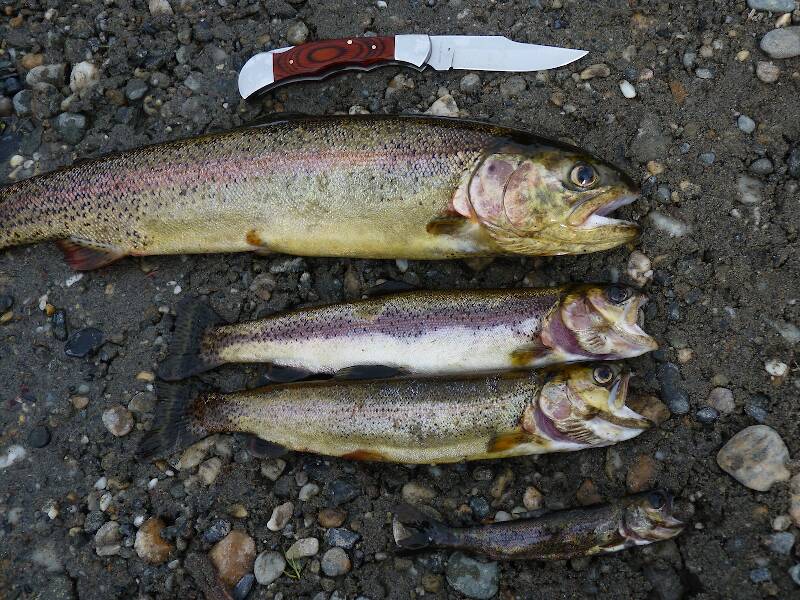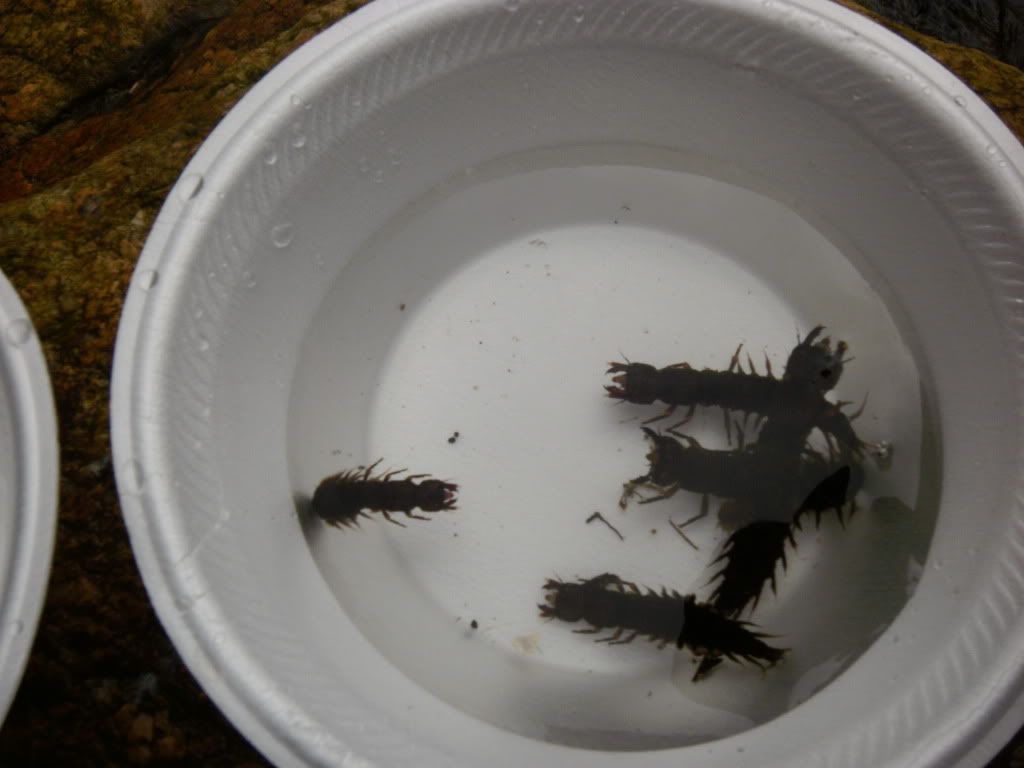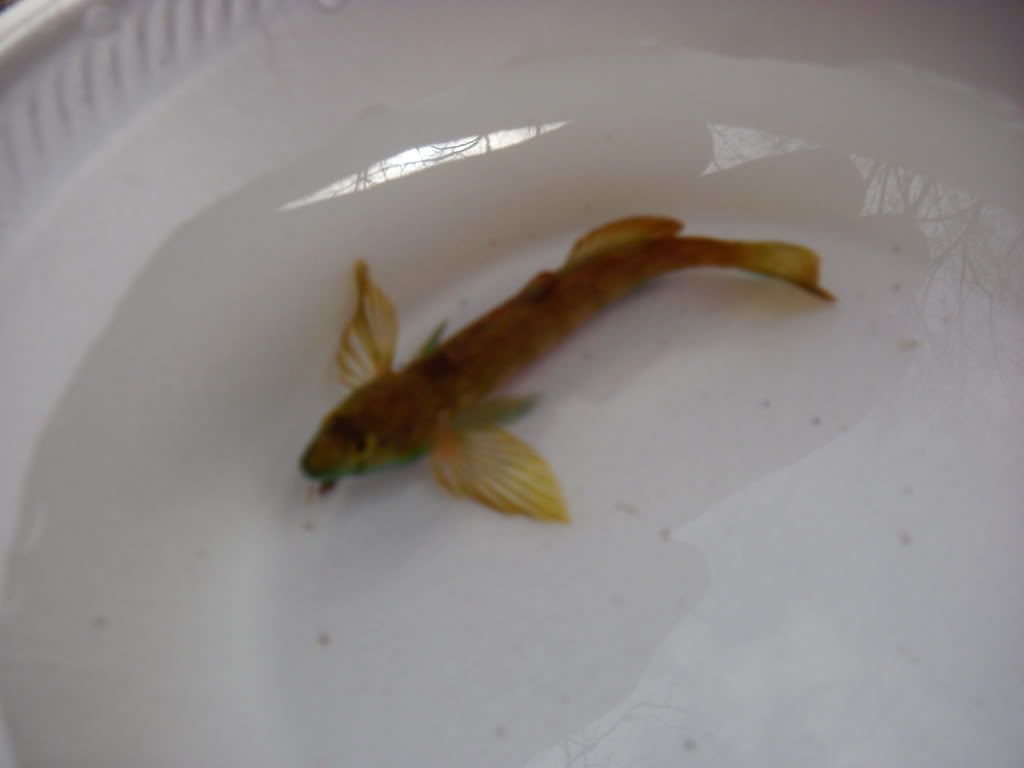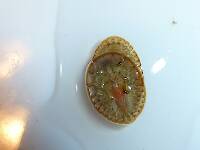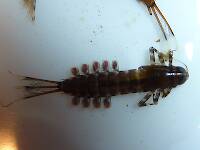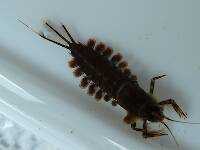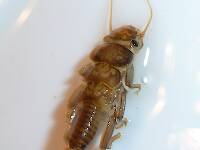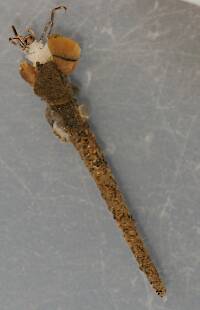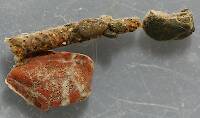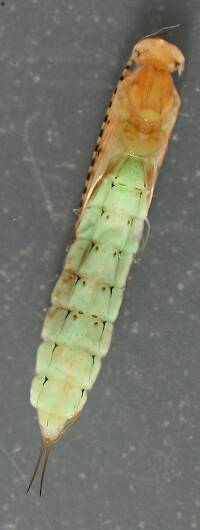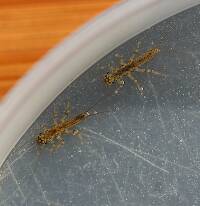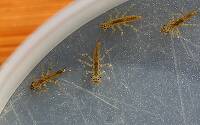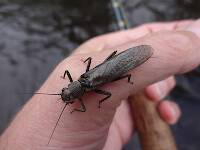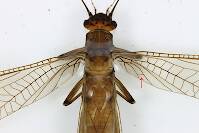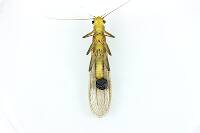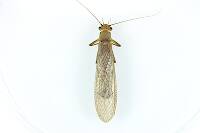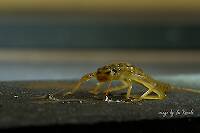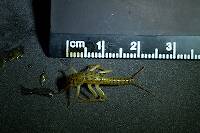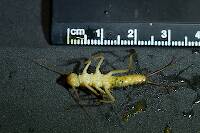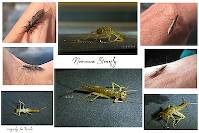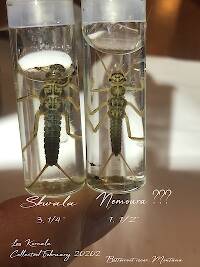
Hex Mayflies
Hexagenia limbata
The famous nocturnal Hex hatch of the Midwest (and a few other lucky locations) stirs to the surface mythically large brown trout that only touch streamers for the rest of the year.
Featured on the forum

I caught this tiny larva without a case, but it seems to key pretty clearly to to Glossosomatidae. From there, the lack of sclerites on the mesonotum points to either Glossosoma or Anagapetus. Although it's difficult to see in a 2D image from the microscope, it's pretty clear in the live 3D view that the pronotum is only excised about 1/3 of its length to accommodate the forecoxa, not 2/3, which points to Glossosoma at Couplet 5 of the Key to Genera of Glossosomatidae Larvae.

Troutnut is a project started in 2003 by salmonid ecologist Jason "Troutnut" Neuswanger to help anglers and
fly tyers unabashedly embrace the entomological side of the sport. Learn more about Troutnut or
support the project for an enhanced experience here.
Cussfly16
Posts: 10
Posts: 10
Cussfly16 on Feb 16, 2012February 16th, 2012, 5:50 pm EST
Hey guys, I have a little problem, today I found a nymph that has the body of a crawler with a light color stripe down its back. Its color was blackish purple with a sort of grayish stripe all the way down its back. We have Iso's in our river and that is their color, but the body shape is very much a crawler. Could it be that it is an immature Iso that has not stretched out yet? I have a pic, but do not understand how to post it... Thanks for the help.
PaulRoberts on Feb 16, 2012February 16th, 2012, 6:04 pm EST
Ephemerella Needhami? There's another that sports a stripe too. Kurt?
Entoman on Feb 16, 2012February 16th, 2012, 7:49 pm EST
Hey Paul -
Yes, the other is Ephemerella aurivillii, which is the direction I'm leaning at the moment only because their pronotums look robust and convex. E. needhami pronotums tend to be narrower with slight concavity tapering towards the head. This is highly speculative without a little more information and better pictures, though.
Cussfly - You're right, they're not Isonychia. Where do these nymphs come from, when were they taken, and what was their size?
Interesting group photo. I've never seen one of a collection tray containing only ephemerellids (crawler mays), corydalids (hellgrammites), and tipulids (cranefly larvae) in the same photo; and they're all pretty close in size! No caddis larvae? Amazing... Edit: That's a snipefly not a cranefly. (See posts below)
Yes, the other is Ephemerella aurivillii, which is the direction I'm leaning at the moment only because their pronotums look robust and convex. E. needhami pronotums tend to be narrower with slight concavity tapering towards the head. This is highly speculative without a little more information and better pictures, though.
Cussfly - You're right, they're not Isonychia. Where do these nymphs come from, when were they taken, and what was their size?
Interesting group photo. I've never seen one of a collection tray containing only ephemerellids (crawler mays), corydalids (hellgrammites), and tipulids (cranefly larvae) in the same photo; and they're all pretty close in size! No caddis larvae? Amazing... Edit: That's a snipefly not a cranefly. (See posts below)
"It's not that I find fishing so important, it's just that I find all other endeavors of Man equally unimportant... And not nearly as much fun!" Robert Traver, Anatomy of a Fisherman
Cussfly16
Posts: 10
Posts: 10
Cussfly16 on Feb 17, 2012February 17th, 2012, 2:44 am EST
Guys, thanks for the quick replies... Actually, what you are looking at on the bottom of the bowl is a caddis. I will see if I can find a better pic to post tonight of him. The picture was taken yesterday and this is from the Chattooga river in South Carolina. It is a bug factory. I am going back today with a friend to get some high quality pics. Our samples yesterday included Hellgrammites of all sizes, cranefly larva, early winter stones, Hendricksons, Quill Gordons, March Browns, Tons of Golden Stones in all sizes, yellow sallies, a couple of glossosoma(I believe), and one sculpin that had an electric blue anal fin... I will try to post more photos later tonight
GldstrmSam on Feb 17, 2012February 17th, 2012, 7:55 am EST
Hey CF16 could you post a photo of that sculpin?
There is no greater fan of fly fishing than the worm. ~Patrick F. McManus
PaulRoberts on Feb 17, 2012February 17th, 2012, 7:56 am EST
Actually the two at the bottom are indeed an immature fishfly (left) and a cranefly larva (right), likely of the family Tipulidae, owing to the split "terminal processes" (tail-like appendages). Unlike caddis, cranefly larvae have no chitenous legs, and the head is tiny and recessed into the body at one end.
Entoman on Feb 17, 2012February 17th, 2012, 8:17 am EST
Cussfly -
Thanks for the additional info. It really helps to give the location, date and sizes. The photo doesn't provide enough morphological detail to make a determination beyond showing they are clearly ephemerellids with a striping pattern that only fits two species, if I remember right. So, we have to rely largely on distribution records for assistance. Based on them, I guess I would agree with Paul and say they're needhami.
If the Critters were from West, I would tell you they were aurivillii. The Northeast has both species, so we'd have to stop at Ephemerella, though aurivillii is believed to be a mid-Summer emerger and wouldn't look very mature at this time. Size can also help if you are fairly confident that they are mature nymphs as needhami runs substantially smaller.
BTW - I'm not seeing a caddis in the picture. You say it's at the bottom. Did the download clip it out?
Edit - I just read your previous post, Paul. If Cussfly is referring to the crane larvae, in addition to the features you mentioned, the prolegs are a giveaway as well (caddis don't have them, Cuss).
Thanks for the additional info. It really helps to give the location, date and sizes. The photo doesn't provide enough morphological detail to make a determination beyond showing they are clearly ephemerellids with a striping pattern that only fits two species, if I remember right. So, we have to rely largely on distribution records for assistance. Based on them, I guess I would agree with Paul and say they're needhami.
If the Critters were from West, I would tell you they were aurivillii. The Northeast has both species, so we'd have to stop at Ephemerella, though aurivillii is believed to be a mid-Summer emerger and wouldn't look very mature at this time. Size can also help if you are fairly confident that they are mature nymphs as needhami runs substantially smaller.
BTW - I'm not seeing a caddis in the picture. You say it's at the bottom. Did the download clip it out?
Edit - I just read your previous post, Paul. If Cussfly is referring to the crane larvae, in addition to the features you mentioned, the prolegs are a giveaway as well (caddis don't have them, Cuss).
"It's not that I find fishing so important, it's just that I find all other endeavors of Man equally unimportant... And not nearly as much fun!" Robert Traver, Anatomy of a Fisherman
Cussfly16
Posts: 10
Posts: 10
Cussfly16 on Feb 17, 2012February 17th, 2012, 1:26 pm EST
Okay guys, even after all these years I am still learning these bugs, and I sure am not going to argue with true bug guys. So the green guy on the bottom of the pic is a cranefly? So is it an immature one? I am going to post a pic of what I thought Crane fly larva looked like, and you all tell me. Today I took a photographer back with a real camera and some equipment to get better pictures. As soon as he sends me the file, I will post more pictures of my kick samples... Okay, I will post the pictures later, they will have to be resent to me because the wrong ones were sent.
Entoman on Feb 17, 2012February 17th, 2012, 1:48 pm EST
Cuss,
Yeah, it's an easy mistake to make. When they are green like this one with it's prolegs sticking out, they can look a lot like a hydropsychid at first glance, but those aren't gills. They grayish ones are easier and when the prolegs are retracted, it makes it even easier as they have that maggoty or botlike look. BTW - I'm not so sure that's a cottid in the last photo.
Yeah, it's an easy mistake to make. When they are green like this one with it's prolegs sticking out, they can look a lot like a hydropsychid at first glance, but those aren't gills. They grayish ones are easier and when the prolegs are retracted, it makes it even easier as they have that maggoty or botlike look. BTW - I'm not so sure that's a cottid in the last photo.
"It's not that I find fishing so important, it's just that I find all other endeavors of Man equally unimportant... And not nearly as much fun!" Robert Traver, Anatomy of a Fisherman
PaulRoberts on Feb 17, 2012February 17th, 2012, 2:28 pm EST
The fish is a darter, not a sculpin. Looks like a cool to warmwater habitat there.
Konchu on Feb 17, 2012February 17th, 2012, 6:54 pm EST
The striped mayfly might be Ephemerella floripara, but it's hard to tell on my screen. "Somebody" lumped it together with E. invaria not too long ago, but "somebody" has been convinced to find favor with the species again due to new ecological and DNA evidence.
Cussfly16
Posts: 10
Posts: 10
Cussfly16 on Feb 17, 2012February 17th, 2012, 11:17 pm EST
You guys have taught me so much...
Entoman on Feb 18, 2012February 18th, 2012, 12:39 am EST
Hi Luke -
Ah, E. floripara! Thanks. I was puzzled by the apparent maturity of these nymphs in the middle of Winter, but failed to put two and two together because I didn't know where these photo's originated and also didn't know (or forgot) they were striped. Are there any other striped species in this genus to be aware of?
Paul & Cussfly -
According to McCafferty in a paper of his back in the mid 80's, this early maturity is what sets them apart and explains why they went undiscovered so long (a different entomologist and his students came upon them in the late 60's). In the same paper he also mentioned that the "other striped species" (needhami) shouldn't be confused with them for this reason. I'm inferring from this that there are no other striped species of ephemerellid but these two in the region. Well, at least I feel better about the pronotums not looking right!:)
Luke -
I didn't know there was controversy regarding this species. A striped invaria hatching in the middle of Winter? Ah, say it ain't so!:) Could you shed a little light on what you mean by "ecological" evidence? Disparity of strains within a watershed? Specialized adaptabilty to unique environmental factors? Isolation? Something else entirely?:)
Sorry for all the questions. I can't help myself.:)
Thanks,
Kurt
Ah, E. floripara! Thanks. I was puzzled by the apparent maturity of these nymphs in the middle of Winter, but failed to put two and two together because I didn't know where these photo's originated and also didn't know (or forgot) they were striped. Are there any other striped species in this genus to be aware of?
Paul & Cussfly -
According to McCafferty in a paper of his back in the mid 80's, this early maturity is what sets them apart and explains why they went undiscovered so long (a different entomologist and his students came upon them in the late 60's). In the same paper he also mentioned that the "other striped species" (needhami) shouldn't be confused with them for this reason. I'm inferring from this that there are no other striped species of ephemerellid but these two in the region. Well, at least I feel better about the pronotums not looking right!:)
Luke -
I didn't know there was controversy regarding this species. A striped invaria hatching in the middle of Winter? Ah, say it ain't so!:) Could you shed a little light on what you mean by "ecological" evidence? Disparity of strains within a watershed? Specialized adaptabilty to unique environmental factors? Isolation? Something else entirely?:)
Sorry for all the questions. I can't help myself.:)
Thanks,
Kurt
"It's not that I find fishing so important, it's just that I find all other endeavors of Man equally unimportant... And not nearly as much fun!" Robert Traver, Anatomy of a Fisherman
GldstrmSam on Feb 18, 2012February 18th, 2012, 8:35 am EST
CF14, I realize that that photo you posted was not a sculpin, but thanks anyway.
There is no greater fan of fly fishing than the worm. ~Patrick F. McManus
Konchu on Feb 18, 2012February 18th, 2012, 2:03 pm EST
Kurt:
There are several striped ephemerellids, but only E. floripara and E. needhami are striped anything quite like this within the genus Ephemerella in the SE USA. Some other genera have dramatic striping, such as Eurylophella and Teloganopsis (the SE T. species used to be in Serratella). Ecologically, the early timing of E. floripara is important, and I'm trying to remember some habitat differences between it and E. invaria, but having little luck with the gray matter at the moment. It's the weekend.
Cuss:
I'd like to see the better picture of the green larva in the bottom right of your original image.
There are several striped ephemerellids, but only E. floripara and E. needhami are striped anything quite like this within the genus Ephemerella in the SE USA. Some other genera have dramatic striping, such as Eurylophella and Teloganopsis (the SE T. species used to be in Serratella). Ecologically, the early timing of E. floripara is important, and I'm trying to remember some habitat differences between it and E. invaria, but having little luck with the gray matter at the moment. It's the weekend.
Cuss:
I'd like to see the better picture of the green larva in the bottom right of your original image.
Entoman on Feb 18, 2012February 18th, 2012, 5:33 pm EST
Luke,
Thanks for the info.
Kurt
Thanks for the info.
Kurt
"It's not that I find fishing so important, it's just that I find all other endeavors of Man equally unimportant... And not nearly as much fun!" Robert Traver, Anatomy of a Fisherman
Taxon on Feb 18, 2012February 18th, 2012, 6:00 pm EST
Cuss: I'd like to see the better picture of the green larva in the bottom right of your original image.
Hi Luke,
Wondered when someone would question that. I'm reasonably certain it's not a crane fly larva, but rather, a watersnipe fly larva of family Athericidae.
Konchu on Feb 18, 2012February 18th, 2012, 6:22 pm EST
i was thinking athericid, too
Quick Reply
Related Discussions
Topic
Replies
Last Reply
9
Jun 19, 2013
by Brookyman
by Brookyman
9
Jun 17, 2015
by Oldredbarn
by Oldredbarn
2
Feb 24, 2020
by Leskorcala
by Leskorcala
8
Jun 12, 2017
by Jmd123
by Jmd123

